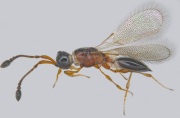 Fig 1. Profile (female) |
 Fig 2. Profile (male) |
 Fig 4. Body profile |
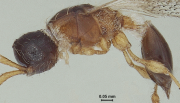 Fig 3. Body profile |
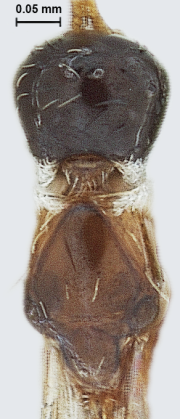 Fig 5. Head, dorsal view |
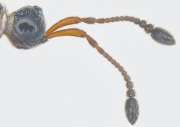 Fig 6. Antenna (female) |
 Fig 7. Antenna (female) |
 Fig 8. Antenna (male) |
|
 Fig 9. Forewing |
 Fig 10. Mesosoma, dorsal view |
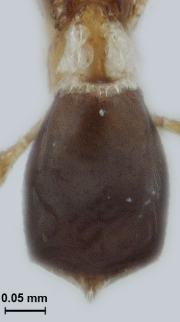 Fig 11. Metasoma |
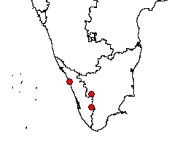 Fig 12. Distribution map |
|
Nomenclature
Monelata Förster, 1856: 123, 127. Type Species: Monelata parvula (Nees von Esenbeck).
Corynopria Haliday, 1857: 170. Synonymized by Dalla Torre, 1898: 598.
Streptopria Maneval, 1939: 168. Synonymized by Masner and Sundholm 1959: 161-168.
Diagnosis
Small sized, slender, gracile, elongate forms (<2mm). Usually yellowish brown to brown or blackish brown or black, head with a deeper colouration. Body smooth, shining, lacking micropilosity, with sparse long semierect hairs, also with dense foam-like scaly structures on post gena, propleuron and petiole. Pronotal collar of hairs dense and distinct, both ventrally and dorsally.
Head mostly subglobular in dorsal view. Antennal shelf well developed. Female antenna 13-segmented, gradually thickened towards tip, without a distinct clava, A13 ovoid and massive, longest and widest of clavomeres, longer than combined length of A11 and A12. A5 to A10 comparatively of smaller size. Antennae filiform and 14-segmented in males, A3 subequal to A4, A3-A13 with long hairs, A4 not modified. Eyes with ommatidia not much prominent. Mandibles normal.
Pronotal shoulder margins obscure due to foamy cushions. Mesoscutum without notauli. Anterior scutellar pit absent, at times seen as a shallow declivity. Lateral and posterior scutellar pits often lacking. Sternaulus often absent. Dorsellum medially with weak longitudinal keels or ridges, often not clear due to dense pilosity. Propodeum with a pointed keel projecting medially, often with a dorsal semi hyaline zone, area between median keel and lateral ones (plicae) not hairy. Metapleuron densely hairy.
Wings usually well developed, but rather narrow. Forewing entire at apex, or with a distinct emargination. Forewing venation extending to its proximal one-third. Submarginal vein closely placed to costal margin, exceeding basal one-third of forewing length. Stigmal vein absent, marginal vein long. Basal vein sometimes indicated as a nebulous arcuate structure. Distal radial sector never indicated, marginal cilia remarkably long, at least one-third of wing width. Hindwings with submarginal vein complete.
Metasoma slender and elongate, petiole at least as long as wide or longer, clothed with dense foamy structures, hiding sculpture beneath and overlapping anterior margin of T2. T2 at its dorso-anterior sometimes with a small cleft or furrow, basal tergites often telescoped under T2, forming broad short triangle. S2 anteriorly with dense pilosity.
Geographic Distribution
For the distribution of the genus in India, see Fig.12.
Species known from India
1. Monelata completa Rajmohana & Narendran
2. Monelata incisipennis Huggert
Remarks
Not common in collections. A slender gracile body, raised antennal shelf, normal mandibles, dense foamy structures and cushion of hairs on post gena, pronotal collar and petiole, antenna 13-segmented in females and 14-segmented in males, the former lacking an abrupt clava, notauli lacking, anterior scutellum without pits, forewing truncate or emarginated distally, a straight petiole and anterior margin of T2 at times incised medially render this genus quite distinct from other genera of Diapriinae.
References
Dalla Torre, K. W. v. 1898. Catalogus hymenopterorum hucusque . . . V: Chalcididae et Proctotrupidae. 1-598.
Förster, A. 1856. Hymenopterologische Studien. II. Heft. Chalcidiae und Proctotrupii, 2: 1-152. Aachen: Ernsteer Meer.
Haliday, A. H. 1857. Note on a peculiar form of the ovaries observed in a hymenopterous insect, constituting a new genus and species of the family Diapriidae. Natural History Review 4: 166-174.
Maneval. 1939. Deux nouveaux genres et un nouvelle espece de Diapriidae (Hym.). Bulletin de la Société Entomologique de France, 44: 168-172.
Masner, L, and Sundholm, A. 1959. Some nomenclatoric problems in Diapriidae (Hym., Proctotrupoidea) Cˇ asopis Cˇ eske´ Spolecˇnosti Entomologicke´ 56: 161-168.
Rajmohana, K and Bijoy, C., 2012. A checklist of Diapriidae and Proctotrupidae (Hymenoptera: Insecta) from India.
|